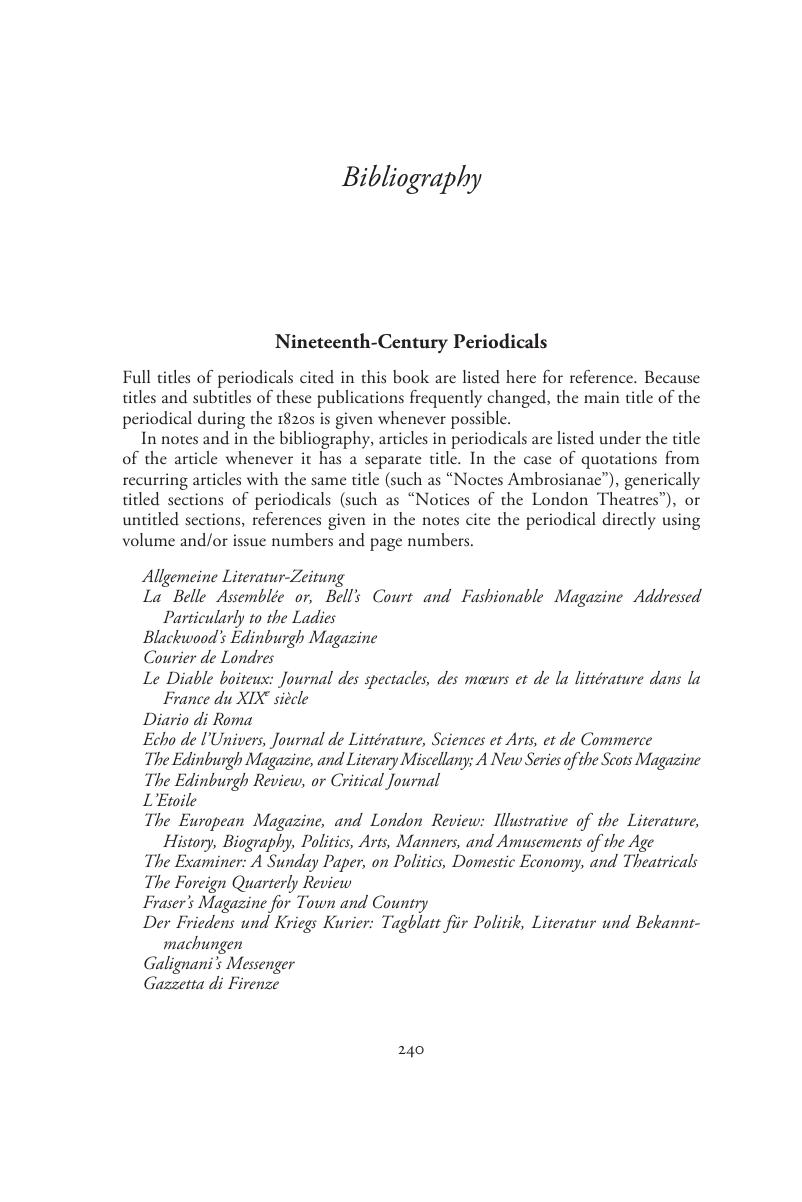Published online by Cambridge University Press: 11 March 2020

Full titles of periodicals cited in this book are listed here for reference. Because titles and subtitles of these publications frequently changed, the main title of the periodical during the 1820s is given whenever possible.
In notes and in the bibliography, articles in periodicals are listed under the title of the article whenever it has a separate title. In the case of quotations from recurring articles with the same title (such as “Noctes Ambrosianae”), generically titled sections of periodicals (such as “Notices of the London Theatres”), or untitled sections, references given in the notes cite the periodical directly using volume and/or issue numbers and page numbers.
Allgemeine Literatur-Zeitung
La Belle Assemblée or, Bell’s Court and Fashionable Magazine Addressed Particularly to the Ladies
Blackwood’s Edinburgh Magazine
Courier de Londres
Le Diable boiteux: Journal des spectacles, des mœurs et de la littérature dans la France du XIXe siècle
Diario di Roma
Echo de l’Univers, Journal de Littérature, Sciences et Arts, et de Commerce
The Edinburgh Magazine, and Literary Miscellany; A New Series of the Scots Magazine
The Edinburgh Review, or Critical Journal
L’Etoile
The European Magazine, and London Review: Illustrative of the Literature, History, Biography, Politics, Arts, Manners, and Amusements of the Age
The Examiner: A Sunday Paper, on Politics, Domestic Economy, and Theatricals
The Foreign Quarterly Review
Fraser’s Magazine for Town and Country
Der Friedens und Kriegs Kurier: Tagblatt für Politik, Literatur und Bekanntmachungen
Galignani’s Messenger
Gazzetta di Firenze
The Gentleman’s Magazine
Le Globe, Journal Littéraire
The Guardian, or, Historical and Literary Recorder
The Indicator
John Bull
Journal für Literatur, Kunst, Luxus und Mode
Knight’s Quarterly Magazine
The Lady’s Magazine; or Entertaining Companion for the Fair Sex, appropriated solely to their Use and Amusement
Landauer Wochenblatt
The Liberal. Verse and Prose from the South
Library of Useful Knowledge
Literarisches Conversations-Blatt
The Literary Chronicle and Weekly Review
The Literary Gazette; and Journal of Belles Lettres, Arts, Sciences, &c.
The Literary Magnet of the Belles Lettres, Science, and the Fine Arts
The London Magazine (as of 1825, The London Magazine and Review)
The Metropolitan Literary Journal and General Magazine of Literature, Science, and the Arts
The Mirror of Literature, Amusement, and Instruction
The Monthly Critical Gazette
The Monthly Magazine; or, British Register
The Monthly Mirror (as of 1812, The Theatrical Inquisitor, and Monthly Mirror)
The Monthly Review, or Literary Journal
Morgenblatt für gebildete Stände
The New Monthly Magazine and Literary Journal
The Panoramic Miscellany; or, Monthly Magazine and Review of Literature, Science, Arts, Inventions, and Occurrences
The Penny Magazine of the Society for the Diffusion of Useful Knowledge
The Philosophical Magazine: Comprehending the Various Branches of Science, the Liberal and Fine Arts, Geology, Agriculture, Manufactures and Commerce
Pierce Egan’s Life in London, and Sporting Guide; Connected with the Events of the Turf, the Chase and the Ring
The Quarterly Review
Revue Encyclopédique, ou analyse raisonnée des productions les plus remarquables dans les sciences, les arts industriels, la littérature et les beaux-arts
The Spectator
The Spy: A Periodical Paper of Literary Amusement and Instruction
Tait’s Edinburgh Magazine
The Tatler: A Daily Paper of Literature, Fine Arts, & Public Amusements
The Thespian Magazine and Literary Repository
The Watchman
The Westminster Review
The World of Fashion and Continental Feuilletons: A Monthly Publication, Dedicated to High Life, Fashionables, Fashions, Polite Literature, Fine Arts, the Operas, Theatres, &c. &c.
Primary and Secondary Sources
To save this book to your Kindle, first ensure [email protected] is added to your Approved Personal Document E-mail List under your Personal Document Settings on the Manage Your Content and Devices page of your Amazon account. Then enter the ‘name’ part of your Kindle email address below. Find out more about saving to your Kindle.
Note you can select to save to either the @free.kindle.com or @kindle.com variations. ‘@free.kindle.com’ emails are free but can only be saved to your device when it is connected to wi-fi. ‘@kindle.com’ emails can be delivered even when you are not connected to wi-fi, but note that service fees apply.
Find out more about the Kindle Personal Document Service.
To save content items to your account, please confirm that you agree to abide by our usage policies. If this is the first time you use this feature, you will be asked to authorise Cambridge Core to connect with your account. Find out more about saving content to Dropbox.
To save content items to your account, please confirm that you agree to abide by our usage policies. If this is the first time you use this feature, you will be asked to authorise Cambridge Core to connect with your account. Find out more about saving content to Google Drive.